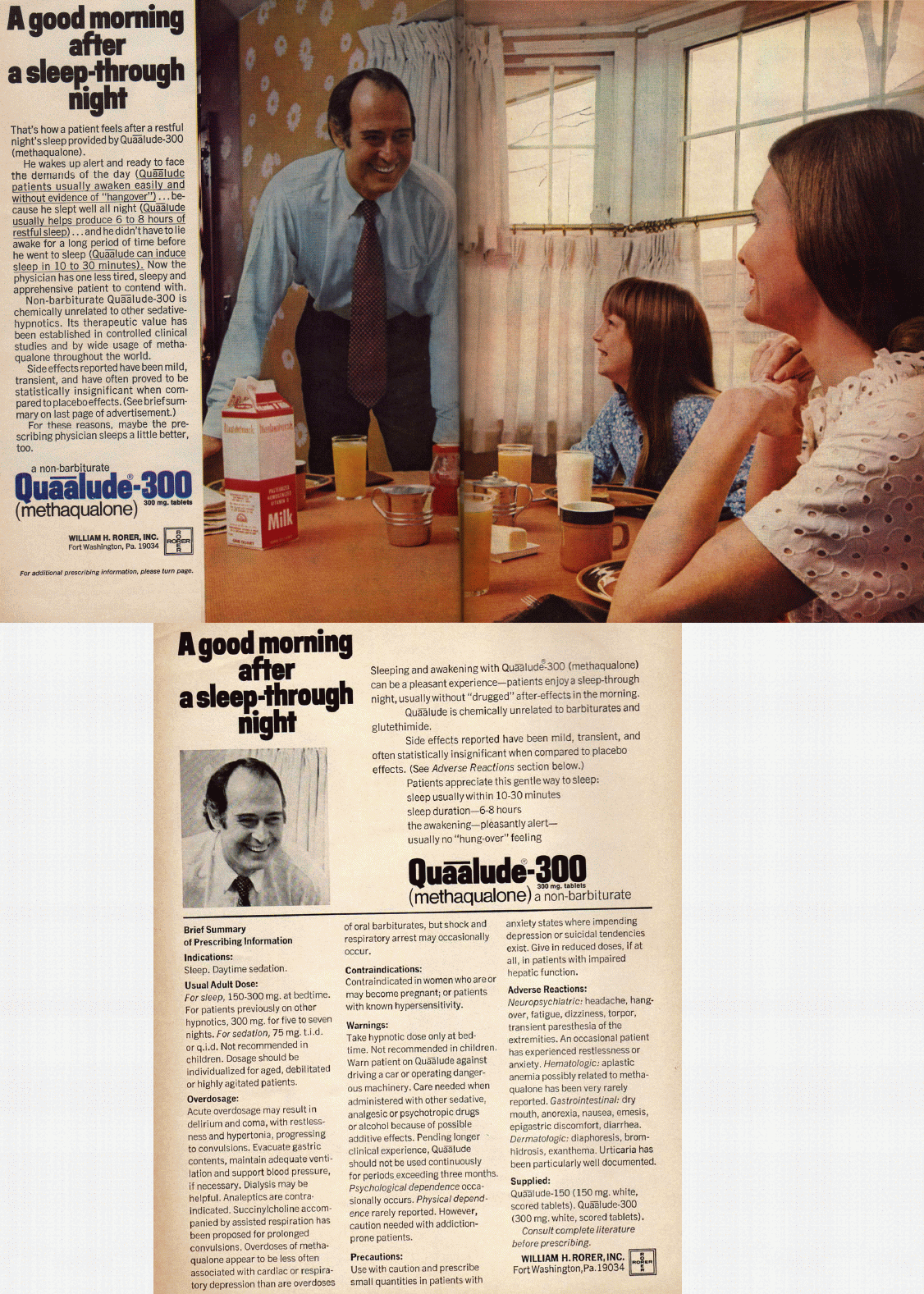
|
Quaalude advertisement, 1971. Archives of General Psychiatry, Vol. 25, No. 5, pp. 30-32. A good morning after a sleep-through night That's how a patient feels after a restful night's sleep provided by Quaalude-300 (methaqualone). He wakes up alert and ready to face the demands of the day (Quaalude patients usually awaken easily and without evidence of "hangover")... because he slept well all night (Quaalude usually helps produce 6 to 8 hours of restful sleep)... and he didn't have to lie awake for a long period of time before he went to sleep (Quaalude can induce sleep in 10 to 30 minutes). Now the physician has one less tired, sleepy and apprehensive patient to contend with. Non-barbiturate Quaalude-300 is chemically unrelated to other sedative-hypnotics. Its therapeutic value has been established in controlled clinical studies and by wide usage of methaqualone throughout the world. Side effects reported have been mild, transient, and have often proved to be statistically insignificant when compared to placebo effects. (See brief summary on last page of advertisement.) For these reasons, maybe the prescribing physician sleeps a little better, too. a non-barbiturate Quaalude-300 (methaqualone) 300 mg. tablets William H. Rorer, Inc. ~ Fort Washington, Pa. 19034 For additional prescribing information, please turn page. Sleeping and awakening with Quaalude-300 (methaqualone) can be a pleasant experience -- patients enjoy a sleep-through night, usually without "drugged" after-effects in the morning. Quaalude is chemically unrelated to barbiturates and glutethimide. Side effects reported have been mild, transient, and often statistically insignificant when compared to placebo effects. (See Adverse Reactions section below.) Patients appreciate this gentle way to sleep: sleep usually within 10-30 minutes ~ sleep duration 6-8 hours ~ the awakening -- pleasantly alert -- usually no "hung-over" feeling Brief Summary of Prescribing Information INDICATIONS: Sleep. Daytime sedation. Usual Adult Dose: For sleep, 150-300 mg. at bedtime. For patients previously on other hypnotics, 300 mg. for five to seven nights. For sedation, 75 mg. t.i.d. or q.i.d. Not recommended in children. Dosage should be individualized for aged, debilitated or highly agitated patients. Overdosage: Acute overdosage may result in delirium and coma, with restlessness and hypertonia, progressing to convulsions. Evacuate gastric contents, maintain adequate ventilation and support blood pressure, if necessary. Dialysis may be helpful. Analeptics are contraindicated. Succinylcholine accompanied by assisted respiration has been proposed for prolonged convulsions. Overdoses of methaqualone appear to be less often associated with cardiac or respiratory depression than are overdoses of oral barbiturates, but shock and respiratory arrest may occasionally occur. CONTRAINDICATIONS: Contraindicated in women who are or may become pregnant; or patients with known hypersensitivity. WARNINGS: Take hypnotic dose only at bedtime. Not recommended in children. Warn patient on Quaalude against driving a car or operating dangerous machinery. Care needed when administered with other sedative, analgesic or psychotropic drugs or alcohol because of possible additive effects. Pending longer clinical experience, Quaalude should not be used continuously for periods exceeding three months. Psychological dependence occasionally occurs. Physical dependence rarely reported. However, caution needed with addiction-prone patients. PRECAUTIONS: Use with caution and prescribe small quantities in patients with anxiety states where impending depression or suicidal tendencies exist. Give in reduced doses, if at all, in patients with impaired hepatic function. ADVERSE REACTIONS: Neuropsychiatric: headache, hangover, fatigue, dizziness, torpor, transietn paresthesia of the extremities. An occasional patient has experienced restlessness or anxiety. Hematologic: aplastic anemia possibly related to methaqualone has been rarely reported. Gastrointestinal: dry mouth, anorexia, nausea, emesis, epigastric discomfort, diarrhea. Dermatologic: diaphoresis, bromhidrosis, exanthema. Urticaria has been particularly well documented. SUPPLIED: Quaalude-150 (150 mg. white, scored tablets). Quaalude-300 (300 mg. white, scored tablets). Consult complete literature before prescribing. William H. Rorer, Inc. ~ Fort Washington, Pa. 19034 |